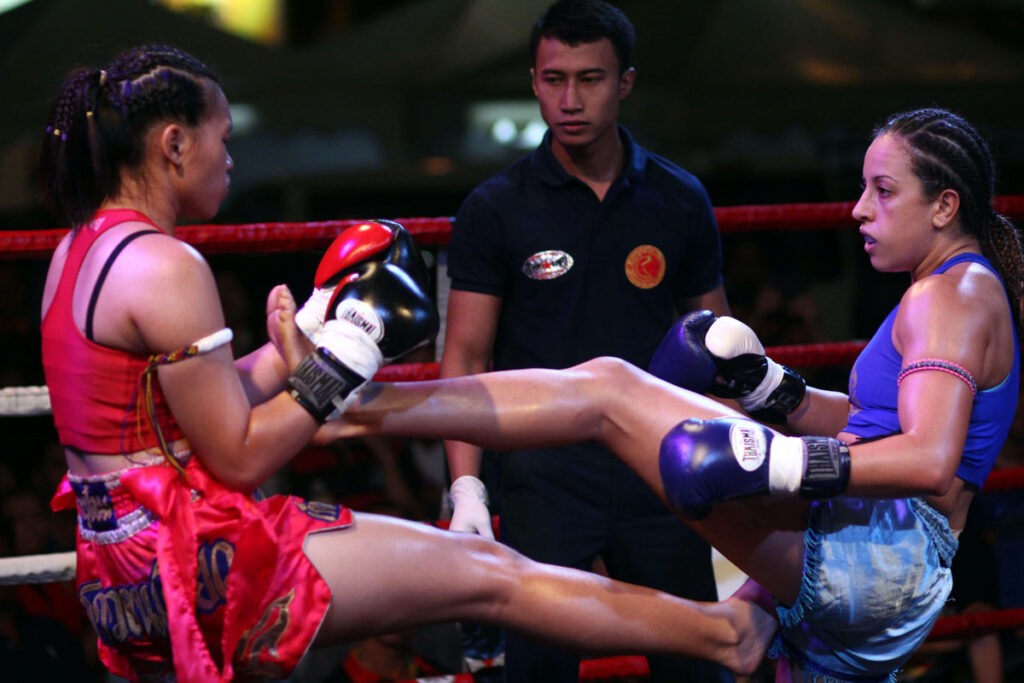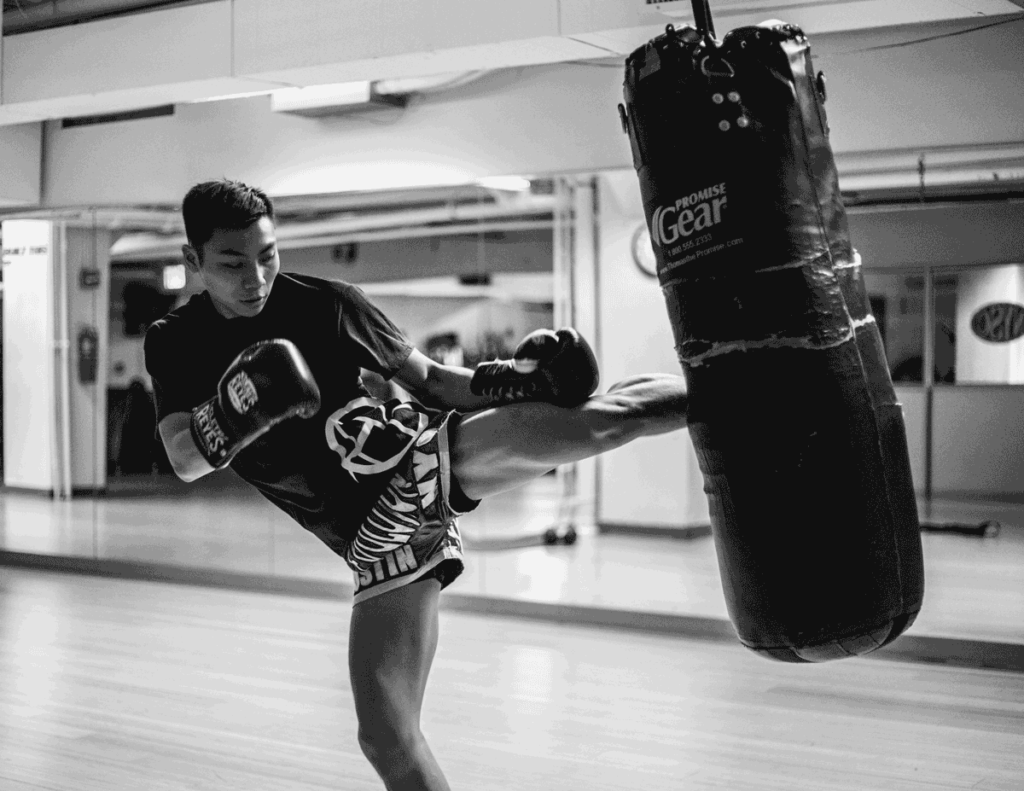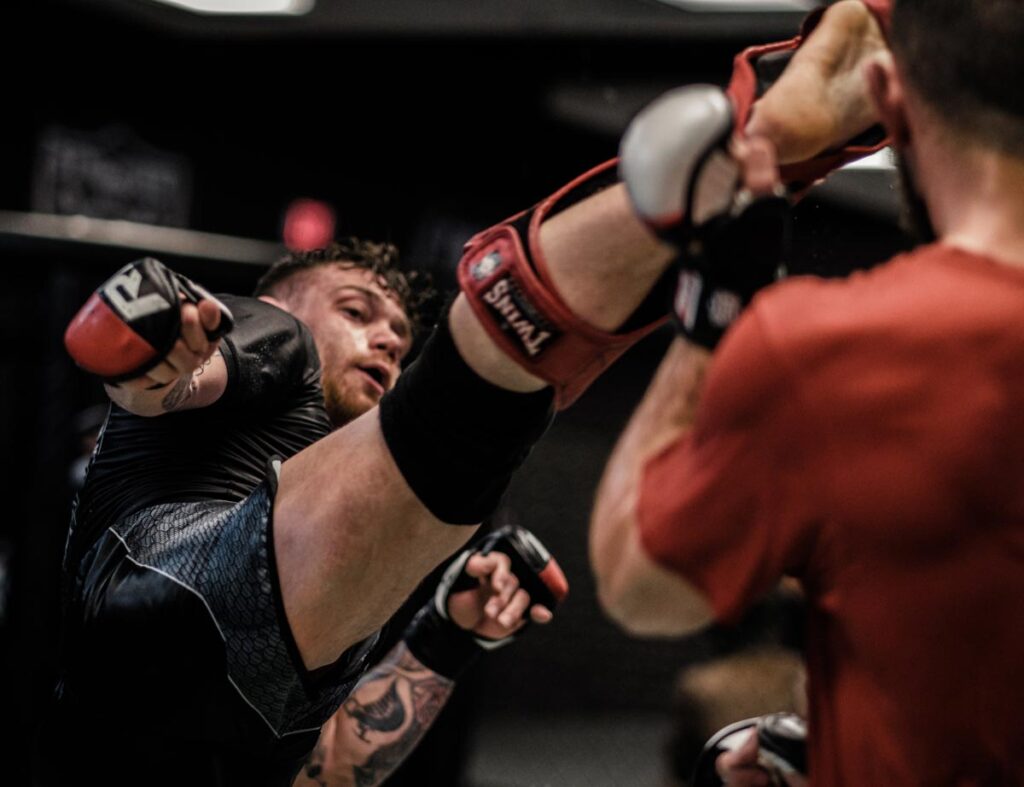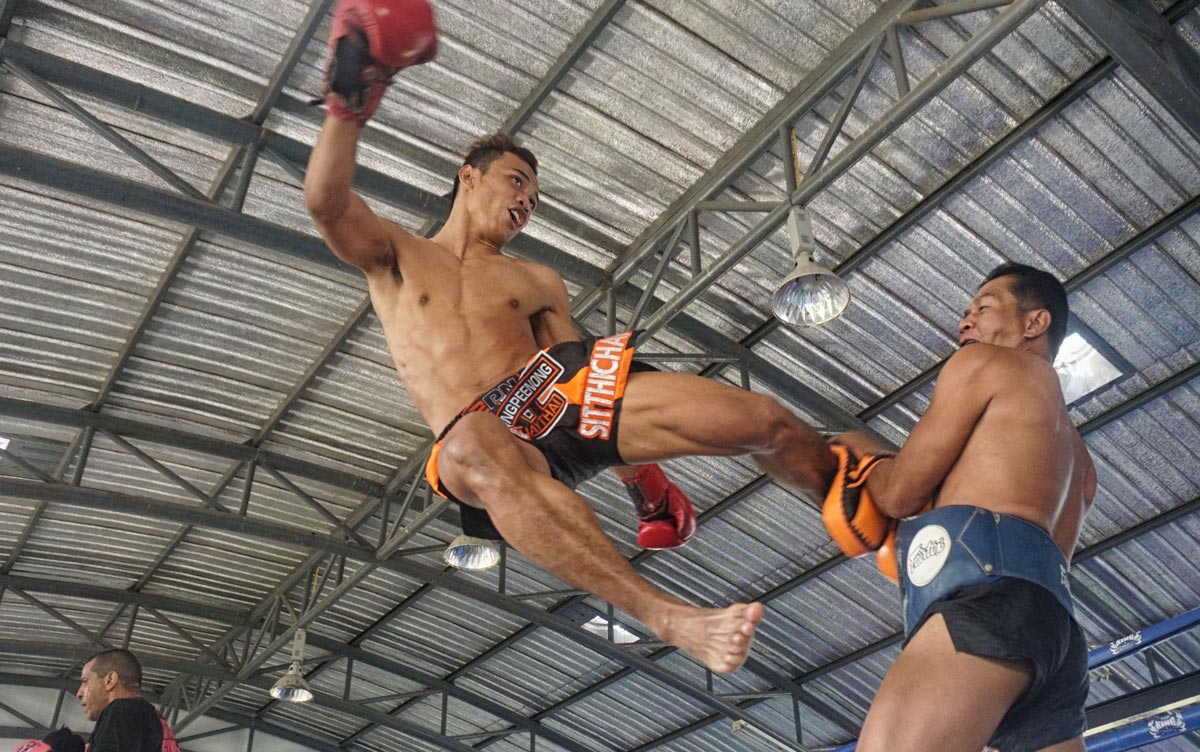There are a ton of Muay Thai kicks.
Muay Thai is excellent at adapting kicks from different fighting styles. And as a form of fighting, Muay Thai allows for some cool personalization.
So today we’ll show you a variety of kicks, plus look at their popular variations, how to train them, and how to defend against them.
I hope you are excited.
Muay Thai Push Kick (Teep)
The push kick is a front kick, also referred to as a teep (trong) or a straight foot jab.
The teep is a fast straight kick with a foot thrust aimed at the knees, solar plexus, chest, or head.
It’s similar to a jab in boxing and has many uses. It can cause damage but it’s also great at distance control. This kick is one of the reasons Muay Thai for self-defense is so effective. It can stop an aggressor in their tracks.
To deliver a teep kick your weight distribution is shifted to the back leg as the front leg thrusts up.
Your knee raises to the height of your target as you push out your foot and thrust your hips forward. To maintain balance, you must position your upper body slightly backwards.
High Teep
High teeps are front kicks to the face or neck. They’re less commonly pulled off as they require a lot of different skills at a high level.
And even if you do have these attributes it’s unlikely you’ll want to throw it often. Even if you do manage to pull one off, your opponent can trip you.
This shouldn’t be confused with a front kick though.
A kick generally involves extending the knee to generate power. A teep however relies on an extension of the hip and a straight front leg to hit the opponent. This is why some may say the teep is like a jab or straight punch, while the front kick is more like an uppercut, and thus more powerful.
Muay Thai Kick: Body Teep

The body teep is a staple Muay Thai strike and unlike the high teep should be used regularly.
It’s great for defensive purposes against aggressive opponents, as it also helps throw them off balance.
But it’s also an effective weapon, especially if directed at your opponents’ solar plexus.
Low Teep
A move that’s become popular among Nak Muay (Muay Thai) and UFC fighters (especially by arguably the best and dirtiest UFC fighter ever) is a low teep to the knee.
By landing the ball of your feet on your opponent’s knee joint, you can deliver serious, potentially lasting damage to the knee.
It’s also excellent when used in combination with other strikes to overload your opponent’s brain and throw them off.
Jumping Push Kick (Teep)
The jumping push kick is not one of the common kicks of Thai boxers as other types of teep kicks, but it does deliver more power.
The jumping kick typically targets the face or upper chest and can be great for throwing your opponent off balance and quickly push an aggressive fighter to the ground.
It’s a perfect technique to learn for self defense as you can then make your escape while your attacker is on the ground.
Muay Thai Roundhouse Kick

While the mechanics of the kick techniques differ, the roundhouse kick is one of the most popular and powerful kicks in all of
It’s certainly one of the most common moves in Muay Thai, but there’s also a Taekwondo roundhouse and many others.
As you’ll see below there are different variations to this kick in Muay Thai. It allows you to deliver a powerful circular strike with different parts of the leg – be it shin, ankle, or foot targeting your opponents legs, head or head.
The kick can be thrown either from the back or front foot however, this will result in a big difference in power. The back foot will, of course, add considerable power to the kick, although the front roundhouse kick will be faster, with less telegraphing.
And due to its mechanics involved, the kick is extremely effective for heavy blows.
An effective roundhouse kick requires strong abdominal muscles and great hip mobility, body, and quick pelvic axial rotation, as you throw your power leg horizontally like a baseball bat.
Let’s take a look at the different versions of this bad boy kick.
Low Roundhouse Kick
Perhaps the most common of all kicks in Muay Thai is the low kick. It’s a leg kick delivered to either side of the thigh and usually targets 5-7 cm above the knee. However, it can certainly be great for knee strikes.
The nerves in this area are sensitive and so it’s actually quite common for fights to be ended after repeated strikes to this area.
And because it maintains the same technique as a typical roundhouse kick with a pivot of the lead foot and hips, the power carried through is significant. However, due to the distance when the kick is usually thrown, its usually your lower shin or instep that makes contact on your opponent.
Dutch fighters are particularly fond of this kick and it has been widely adopted throughout Mixed Martial Arts (MMA) as a result of its effectiveness.
Roundhouse Kick to Body
The roundhouse kick that targets the body is typically aimed for the ribs, liver, kidneys, or spleen.
Not only is the height different from a low kick, but also the movement required.
To deliver maximum power, it’s best to use your upper body as well to turn into the kick. Your upper body turns to the opposite side and counteract for balance.
The point of contact is also different, with your shin delivering the brunt of the impact.
Mike Tyson has said that in his heyday, he’d imagine punching through his opponent’s head to increase power.
And we want to do the same when kicking to the body. You’ll want to aim for a point behind your target as if your goal is to kick through your opponent.
Then once you’ve delivered the strikes to your opponent, you must revert your foot back to its starting position in a whipping fashion, with your hips and arms returning to starting positions.
This kick can also severely damage your opponent’s cardio, core muscles, blocking arms, or set them up for an eventual head kick.
After repeatedly delivering roundhouse body kicks, your opponent is more likely to anticipate another leaving their guard down and open for head kicks.
Roundhouse Kick to the Head

Aptly named, this roundhouse kick targets the head and neck.
Due to the distance, these kicks are mostly delivered with the ankle or foot.
It’s considerably more dangerous and a true fight finisher.
If delivered correctly and only partially blocked will likely result in a knockout or at least knockdown and potentially even death.
But it also requires considerably greater flexibility and hip mobility than other roundhouse kicks. Plus it’s harder to pull off as the distance required includes more telegraphing.
That’s why mixing it up with other roundhouse kicks, particularly the body kick (sometimes called mid kicks) is usually necessary.
Muay Thai Switch Kick
The switch kick is sometimes seen as a roundhouse kick with a twist. It’s commonly used when kicking with the left leg from the orthodox fighting stance as the fighter needs to quickly switch lead legs.
This helps generate the same devastating power with both legs.
It’s also helpful for tricking your opponent with quick footwork.
As a result, timing and speed is key. Particularly important is that you don’t jump. You don’t want both of your feet to leave the ground at the same time as this will result in an easy sweep.
Muay Thai Side Kick
The side kick or ‘diagonal kick’ is a very quick and effective kick aimed at the opponents lower rib-cage and striking with the shin.
With traditions in Taekwondo and Karate, the side kick is a great defensive kick with devastating effects.
However, like the spinning back kick, it can be quite dangerous in Muay Thai as it leaves your back open for attacks.
Spinning Back Kick in Muay Thai
Sometimes mistaken as more of a Taekwondo or karate move than Muay Thai, it actually has its roots in Muay Thai extend back to an ancient Muay Boran move, Jarakhe Fard Harng (Thai: จระเข้ฟาดหาง) which translates to “alligator tail”.
One caveat about this kick for Muay Thai, though is that it leaves your back open and so it’s not so commonly used. However, when it is used and actually lands, it can be very devastating.
They’re usually thrown to the ribs, neck, or even head (like the spinning hook kick in Taekwondo). And since it’s not so commonly used, you can enjoy the element of surprise.
To get the movement down though, you’ll need to drill it a ton first on a bag, then with your trainer holding pads.
Question Mark Kick in Muay Thai
Here is one of the trickiest kicks of them all, best left to martial artists with advanced flexibility and balance.
It is sometimes used in the UFC by the likes of great strikers like Isreal Adesanya and Luke Rockhold however the dexterity required makes it rather rare.
While much of the mechanics are similar to a roundhouse kick, the question mark kick is a deceptive technique. It’s delivered at a downward angle once the kick reaches its maximum height.
Muay Thai’s Axe Kick
The axe kick is Muay Thai’s version of Taekwondo’s dropping heel kick.
It’s called an axe kick because it involves throwing your leg down on your opponents head like an axe.
This obviously requires incredible flexibility and isn’t so commonly used in competition at least not effectively as it usually misses.
Note that it can be easily countered either with a sweep, throw, or push kick, so it’s not exactly recommended that you try this at home.
But if there is a noticeable skill discrepancy, this kick can be a crowd pleaser and has been used by Saenchai in fights.
Muay Thai Cartwheel Kick
This is another very flashy kick occasionally used by confident fighters like Saenchai that look impressive but rarely result in anything significant.
While on the surface it seems to be a modern technique, the cartwheel kick actually evolved out of Muay Boran with a strike called Ma Deed Kra Lok (Thai: ม้าดีดกระโหลก) which roughly translates as “horse kick”.
And according to conventional Muay Thai rules, the technique isn’t even legal since it requires your hand to touch the canvas before your kick lands.
However it is still used, as well as occasionally in MMA fights.
How to Train Muay Thai Kicks
Muay Thai training requires a ton of drills. And this is especially true to master kicks.
Bag Work
Bag work, particularly heavy bag training is necessary for anyone getting into Muay Thai.
Kicking a heavy bag can help you hone your technique. Plus it’s extremely helpful with Muay Thai shin conditioning.
And it’s excellent for training at home as you won’t need a partner to get a great and effective workout in. It can even be used for daily training.
Pad Work
As you hit the bag, you’ll also want to mix it up with some pad work.
This helps to practice hitting a smaller, moving target and can make great use of a training partner.
Make sure though, that when you’re holding pads for your partner, that you tuck your elbows in brace before impact.
This will protect your elbows and provide your partner with an effectively hard surface to strike, further helping shin conditioning.
Sparring
Here’s where you put your bag and pad work into practice. Muay Thai sparring is a necessity for any effective Muay Thai training and will help familiarize yourself with the movement involved in effective Muay Thai kicking.
It is absolutely the best way to test and improve your skills.
Just make sure that you avoid using powerful strikes with full force (like elbow strikes) which can injure your partner.
To get the most out of sparring in the beginning, make sure you and your partner agree to use minimal strength and instead focus on technique. This may require you to spar at a reduced speed at first but this will help you piece everything together in the beginning without overloading your brain.
You’ll need boxing gloves and shin guards and just in case – a mouth guard although you’ll want to mostly focus on body strikes and leg kicks.
Eventually you will want to incorporate everything though you so you can practice head movement.
How to Defend a Muay Thai Kick
No guide to Muay Thai kicking would be complete without also including ways to defend. And luckily there are many ways to do this.
The most commonly used ways to defend are blocking, catching, avoiding, and stopping altogether.
Blocking Muay Thai Kicks
A block is any technique that uses one of your body parts like leg, knee, arms, or elbows to stop an attack from reaching your body or head.
Bones are largely made of calcium, magnesium, amino acids, and other minerals, not including concrete and so they’re not impervious to injury with this method.
And while the bone does technically have a protective ‘bone membrane’ it is fragile.
This is why trying to strengthen your bones is usually a fools errand. Shin conditioning is one thing. And is necessary to endure the inevitable pain involved with Muay Thai but repeatedly and intentionally injuring your bones is something else.
You don’t strengthen your bones. You increase your ability to endure pain.
Catching Muay Thai Kicks
This is another very important technique to learn. It requires you to move with the power of the kick or other oncoming strike. And many professional fighters, especially those with Sambo or other grappling backgrounds may rely on catching kicks to impose their will.
This will help neutralize its power, and as you catch the leg (in this case) with your arm you then ideally counter-strike with an attack of your own while your opponent is unbalanced.
You can do a lot from this position, including spinning elbow techniques, pushing, sweeping, or anything else you like.
Avoiding Muay Thai Kicks

Avoiding a Muay Thai kick is the undefeated champion of defensive moves you can learn.
But it is also the hardest to achieve – usually requiring countless hours of sparring to read opponents hips and footwork.
It also requires a degree of speed some of us could only dream of.
Luckily there are many ways to avoid kicks but the best require the least amount of energy and movement possible. For instance simply tilting your upper backwards to avoid a high kick. Or slipping sideways to avoid a front kick.
And the beautiful thing about avoiding kicks is that it allows you to deliver a low kick (or any other possible) as your opponent resets.
Stopping Muay Thai Kicks
Okay I lied. Avoiding Muay Thai kicks is tied for champion with stopping a kick altogether.
This is where a teep kick really comes into play as being a fundamental technique literally everyone should learn.
A front kick to the knee or to the chest of an oncoming aggressor can put them in their place… on the ground with a painful injury.
This is a very safe route and one of the safest defensive tactics you can use.
One that’ll hopefully help you avoid getting into any danger at all.
